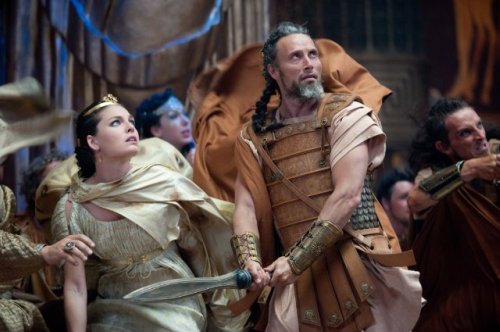Review: Clash of the Titans

Director Louis Leterrier (The Incredible Hulk) pays homage to stop-motion king Ray Harryhausen with his own version of Clash of the Titans, based on Harryhausen's 1981 original. Harryhausen's films from the 1950s through 1970s were full of amazing monsters and stop-motion action, most notably Jason and the Argonauts, The 7th Voyage of Sinbad and One Million Years B.C. Like Harryhausen, Leterrier brings to life the mythical world of the Greek gods through larger-than-life monsters and the golden ethereal world of Mt. Olympus.
The 2010 version of Clash of the Titans begins with the infant Perseus discovered afloat at sea by a poor fisherman. Perseus (Sam Worthington) turns out to be the son of Zeus but is raised as a man, and watches helpless as his family dies from the wrath of Hades (Ralph Fiennes), god of the underworld. Mankind is defiant, and the gods retaliate by allowing Hades to teach a lesson to the arrogant king and queen of Argos. With his anger against Hades fueling him, Perseus volunteers to lead a dangerous mission to defeat the Kraken before it either destroys Argos or takes the sacrifice of the princess Andromeda (Alexa Davalos). Meanwhile, Hades plots to seize power from Zeus (Liam Neeson) and unleash hell on earth.
Leading a daring band of warriors, Perseus sets off on the perilous journey to battle witches and Medusa as he seeks a way to kill the Krakken and weaken Hades. Accompanied by his spiritual protector Io (Gemma Arterton), older seasoned soldier Draco (Mads Mikkelsen) and a ragtag crew of young soldiers and mercenaries, Perseus must return to Argos before the eclipse and the fate of Argos and Andromeda is sealed by death and destruction. Intent on denouncing his demigod power and gifts from Zeus, he is determined to defy fate and create his own destiny.
The visual elements from the digital animation, art direction and special effects of Clash of the Titans are incredible, but suffer at the hand of post-production 3D. The dark tones that should typically contribute effectively to the solemness of the Underworld as well as mythical characters such as the harpies are indistinctive when wearing the RealD 3D glasses. Had 3D not been an afterthought, there could have been better implementation of 3D effects in several of the battles and flights.
I still enjoyed the action scenes, especially those involving giant scorpions, and the visualization of the Stygian Witches who must share one eye between them. Much of the stunning cinematography across the rugged scenery was filmed in Wales and through the Teide National Park in the Canary Islands off the coast of Spain.
As can often happen with a film such as Clash of the Titans that relies heavily on special effects, the story development as well as the direction of the cast and as well as their performances fall flat without much depth. Sam Worthington as Perseus comes across a bit wooden, and I never felt connected to his character other than his grief at losing his family in the early scenes. Speaking of wooden, Clash introduces a race of Jin who are reminiscent of the Sand People of Star Wars. The most notable performances were from veteran actors. Liam Neeson was well-cast as Zeus, although he comes across a bit more benevolent than I'd expect. I didn't recognize Mads Mikelssen (Le Chiffre in Casino Royale and Quantum of Solace), but I absolutely adored his role and the dry humor that was given to his character.
Just as Harryhausen paid homage to the new visual artistry exemplified by George Lucas in Star Wars, the mechanical owl Bubo makes a brief cameo appearance in the latest version of Clash of the Titans. I think fans of the original Clash of the Titans would have been disappointed if this element had been completely left out -- although overall most fans of the original will leave the theater disappointed.
When asked if I would recommend this movie, my one word response was "Meh." Leterrier's version doesn't meet let alone surpass Harryhausen's version of Clash of the Titans, and both the journey and climax of this film seem a half-hearted attempt at the mythologies -- both Greek and film -- that were legendary.

